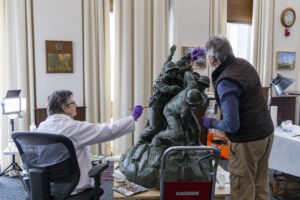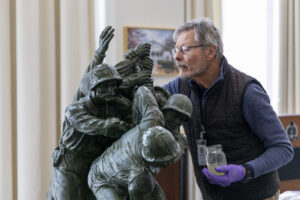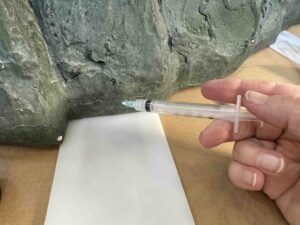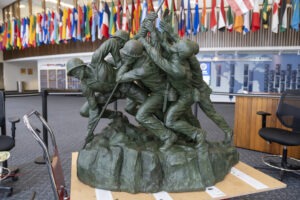Ahead of the 80th anniversary of the Battle of Iwo Jima, the plaster replica of the Marine Corps Memorial sculpture in the U.S. Naval War College’s (USNWC) Spruance Auditorium underwent careful conservation. Conservation is being supported in part by a Federal Save America’s Treasures grant administered by the Institute of Museum and Library Services. We sat down with the conservator, Rika Smith, to learn more about the project.
How did you come to work with substantial works of sculpture?
I started out as a fine arts major in an art school, and I went to the Rhode Island School of Design (RISD). In junior year at RISD, you have the option of studying in Rome for an entire year, which I did, and I just loved it. One of the things about Rome is that you learn so much about monuments, architecture, and how they shape the history of a city.
While we were there, we visited numerous art restorers, mostly working on paintings, but the part I loved the most was going to the Roman Forum. It was huge. There was restoration happening all over the place, and I just loved it. When I came back home, I was very lucky to get a job at the Isabella Stewart Gardner Museum in Boston, which is the closest thing to Italy I could find.
After being there for two years, I decided I just loved it, and so I went on to get a master’s degree at the University of Delaware Winterthur program. Then, after that, I did a postgraduate year at Harvard working on materials research. Part of the research I did was figuring out the best type of coating to protect outdoor sculptures. And that’s really how I got into it.
What is your approach as a conservator?
My approach as a conservator is to first do no harm, take a long time to look at the artwork, and really research the artist, their technique, and how they would probably have liked something conserved. The most important thing is to be very cautious, and it makes sure that you have looked at everything. We look at things with ultraviolet light, raking light, and under the microscope, and sometimes we have materials analyzed to help with this.
What condition was the sculpture in when you first conducted the assessment?
The Iwo Jima sculpture had paint flaking on the base surrounding it, and the little flecks of paint actually looked like dried cornflakes. We also noticed that there was a wax coat on the surface.
We were able to get the conservation treatment report from a previous conservator from 1999, and they were very thorough in their report. They used many different types of adhesives and paints, so we had to be certain that we used materials that would work with the previous adhesives and paint.
What were your first few steps in conducting work on the sculpture?
We knew there was not a wax step mentioned in the previous conservator’s report, but we could see it on the surface and touch it.
So, the first thing we did when we started working was to remove the dust from the surface while avoiding all areas where the paint was actively flaking—even if you breathed on it, some of the paint would flake off. So, after we did that, we carefully cleaned the surface, and we used a naphtha soap to do that because we knew that could take off the wax. When that was done, we set down all the flaking paint, which you do by introducing an adhesive with a very small brush and then setting the paint down to the surface.
What was the most challenging aspect of this project?
The biggest challenge for us has been the amount of wax on the surface, particularly on the base. Because the previous report was very detailed but did not mention wax, I thought that it had not been waxed by the conservator. What we think happened is that someone at the College decided to wax it because that would be a treatment typically done for bronze. Of course, the sculpture is not bronze; it’s unpainted plaster.
So, the wax on the surface, I think, must have been applied at least five times. I assume it was a maintenance choice, thinking it would be good for the sculpture, but it made it very difficult for us to apply the protective coating on the surface and to do in-painting. However, we managed to do it by playing around with different conservation materials.
The sculpture had also sustained damage from sunlight. The curtains in the room had often been open, and you could see light damage on the base and to the paint. So, what we did was apply a protective coating on top that was satin and contained a UV light inhibitor, which should help preserve the sculpture in the future. That surface is also quite hard and would be very easy to dust with a microfiber cloth or a feather duster.
What most interested you about the project?
One of the most fascinating things for me about this project is that Felix de Weldon, when he painted the piece, did not paint it a solid green. He painted it with more of at least one color of brown as a base coat, and then he applied three different green colors on top. That was a very active brushwork. The amazing thing about that is that it’s the way one would patinate a bronze. You would first apply a brown layer, the chemical called ferric nitrate, and then on top of that, you would apply different green colors. It makes the surface really lively, and it looks just like a real bronze, which is why it’s very understandable that numerous people would think it’s a bronze.
The nice thing about the ending of the project is that the piece is now in stable condition. Nothing is going to happen to it. It will be on display where it has been, and it looks great. And in the future, it’s going to be very easy to take care of.




